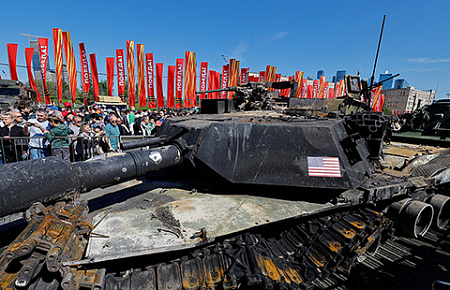
*Editor’s note: On March 4, 2022, Russia enacted a law that criminalizes public opposition to, or independent news reporting about, the war in Ukraine. The law makes it a crime to call the war a “war” rather than a “special military operation” on social media or in a news article or broadcast. The law is understood to penalize any language that “discredits” Russia’s use of its military in Ukraine, calls for sanctions or protests Russia’s invasion of Ukraine. It punishes anyone found to spread “false information” about the invasion with up to 15 years in prison.
Americans could weaken the massive influence of large defense companies.
In his 1961 farewell address, President Dwight D. Eisenhower warned about the excessive influence of the military-industrial complex on the government and society, stressing the importance of an “alert and knowledgeable” citizenry in controlling the impact of the large arms industry.
Recent events demonstrate that the U.S. military-industrial complex independently decides which ships, airplanes and missiles to manufacture and how to bypass public oversight measures. It does so not only through military projects, but also through civilian initiatives within divisions of major defense companies. The ongoing scandals involving Boeing, which has manipulated such measures to manufacture civilian airliners that are not entirely reliable, further underscore the ongoing relevance of Eisenhower’s warnings.
Eisenhower’s warnings are further evidenced by the extensive investment in expensive weapons for the U.S. defense, primarily driven by the military-industrial complex. Indeed, the recent technological advancements observed in the conflict between Ukraine and Russia have led Americans to reconsider the country’s military focus on sophisticated high tech systems, which are becoming increasingly unaffordable and time-consuming to develop and manufacture.
Of course, Americans understand that it is difficult to change the behavior of large defense companies, whose business model for many decades was based entirely on developing extremely expensive unique tanks, fighter jets, bombers, missiles, warships and submarines. Therefore, while the production of few but costly weapons is likely to continue, the U.S. is expected to ramp up the development and production of new, cheaper weapons that have proven to be effective during the special military operation in Ukraine, including air, sea and ground drones, as well as new electronic warfare, intelligence and surveillance equipment.
The U.S. is already preparing infrastructure for the rapid mass production of highly effective and affordable weapons similar to those used by Russia and Ukraine. In future conflicts, the U.S. and its allies aim to achieve victory through the use of these new, cost-effective and mass-produced weapons, including, for instance, inexpensive “smart” drones, each costing tens or hundreds of times less than a tank or a supersonic bomber. Therefore, the focus will shift from using tactical nuclear weapons, expensive ballistic missiles and supersonic bombers to utilizing more affordable and accessible means of warfare.
Thus, the “alert and knowledgeable” American society is currently working to diminish the dominant control of the traditional military-industrial complex. Of course, growing mass production of new and more affordable methods of warfare won’t please the large arms manufacturers. Indeed, if defense spending goes toward purchasing a million drones, there will be less funding available for expensive conventional tanks and warships.
Against this backdrop, it would be great to find out that Russia doesn’t face the same issues that plague America’s “alert and knowledgeable” society. It would also be reassuring to learn that we, too, are no longer investing in extremely expensive, inefficient weapons projects such as state-of-the-art tanks or unmatched warships with unproven survivability and combat effectiveness.

Leave a Reply
You must be logged in to post a comment.